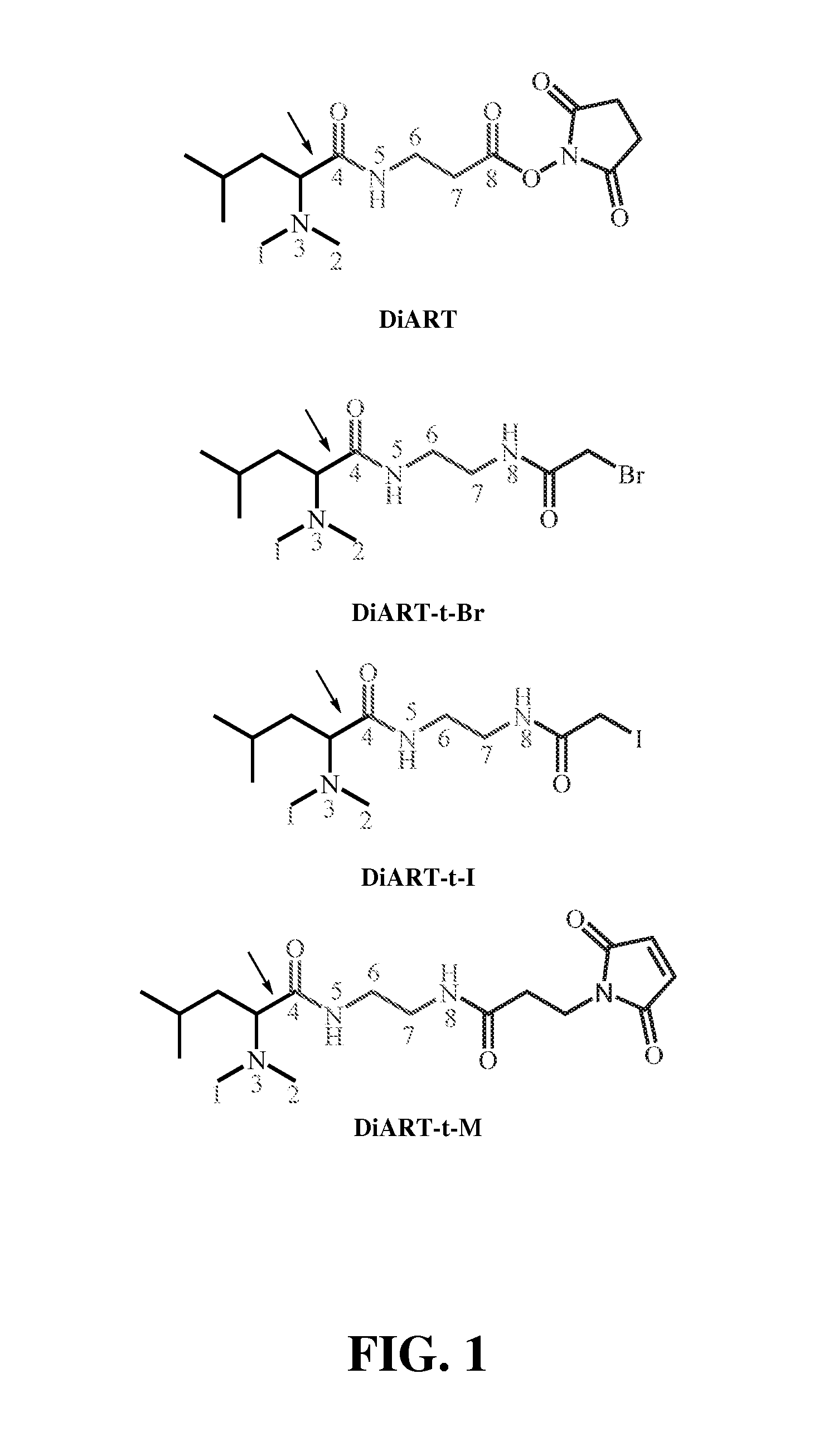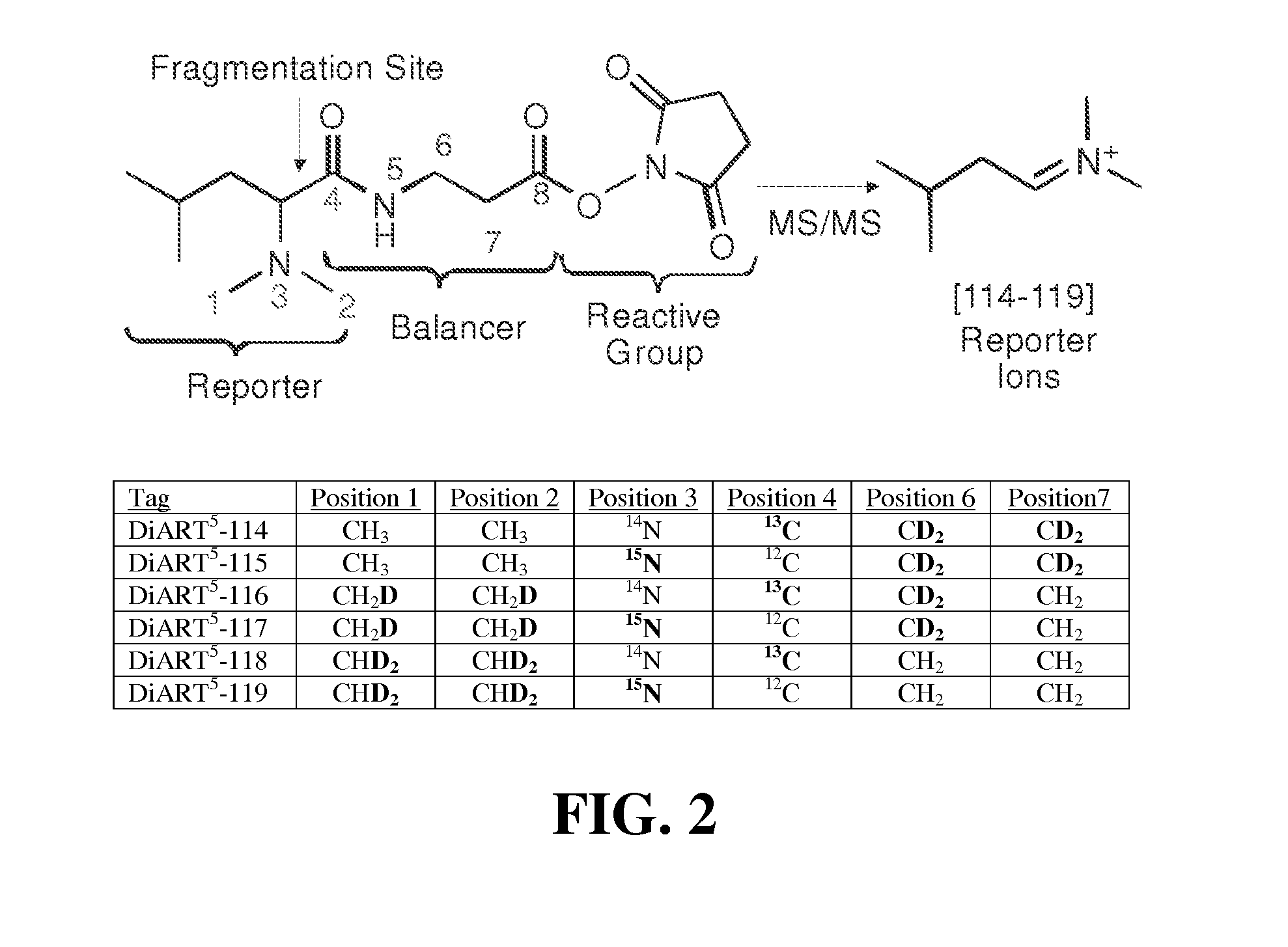Deuterium isobaric tag reagents for quantitative analysis
- Summary
- Abstract
- Description
- Claims
- Application Information
AI Technical Summary
Benefits of technology
Problems solved by technology
Method used
Image
Examples
example 1
Synthesis of Non-Isotope Labeled DiART Reagents
[0078]DiART reagents were synthesized by following the scheme illustrated in FIG. 3.
Compound 1:
[0079]Formaldehyde (HCHO / DCDO, 16 mmol) was added into a suspension of leucine (2 mmol) in methanol (8 mL) and acetic acid (400 μL) at 0° C., followed by reductive reagent (sodium cyanoborohydride / deuteride, 5 mmol). The mixture was stirred at ambient temperature for 12 hours. It turned to clear solution after several hours. The methanol and excessive formaldehyde were removed in vacuo. The residue was taken up in methanol (20 mL) and dried with anhydrous Na2SO4. The concentrated syrup was used in the next step directly without further purification.
Compound 2:
[0080]A 250 mL Round-bottomed flask equipped with a reflux condenser was loaded with β-alanine (4.5 g, 50 mmol), benzyl alcohol (15 mL) and toluene (30 mL) at room temperature. p-Toluenesulfonic acid monohydrate (9.6 g, 50 mmol) was added under stiffing. The resulting solution was stirre...
example 2
Synthesis of Non-Isotope Labeled DiART-t Reagents
[0085]DiART-t reagents were synthesized by following the scheme illustrated in FIG. 4.
Compound 1:
[0086]Formaldehyde (HCHO / DCDO, 16 mmol) was added into a suspension of leucine (2 mmol) in methanol (8 mL) and acetic acid (400 μL) at 0° C., followed by reductive reagent (sodium cyanoborohydride / deuteride, 5 mmol). The mixture was stirred at ambient temperature for 12 hours. It turned to clear solution after several hours. The methanol and excessive formaldehyde were removed in vacuo. The residue was taken up in methanol (20 mL) and dried with anhydrous Na2SO4. The concentrated syrup was used in the next step directly without further purification.
Compound 2:
[0087]N,N′-dicyclohexylcarbodiimide (DCC) was added into a solution of Compound 1 (2 mmol) and N-methylmorpholine (660 μL, 6 mmol) in dichloromethane (DCM) (30 mL) at 0° C. The resulting mixture was stirred at 0° C. for 2 min, and mono N-Benzyloxycarbonyloxy-ethylenediamine (388 mg, ...
example 3
Isotope Purity of DiART Reagents
[0091]The isotope purity of each DiART reagent synthesized as above was determined by fragmenting the reagent in a LTQ-Orbitrap MS / MS spectrometer and measuring intensity of all peaks between 114 and 121. Table 7 provides the results of isotope purity from one batch of DiART reagents. These values are included in a configuration file on a Mascot server to correct quantitation error caused by isotope impurities.
TABLE 7Δ(M / Z)−2−10+1+2DiART-1140.0000.0000.9850.0150.000DiART-1150.0000.0080.9870.0050.000DiART-1160.0000.0100.9820.0080.000DiART-1170.0000.0090.9790.0120.000DiART-1180.0000.0050.9800.0150.000DiART-1190.0000.0060.9850.0090.000
PUM
| Property | Measurement | Unit |
|---|---|---|
| Force | aaaaa | aaaaa |
| Force | aaaaa | aaaaa |
| Mass | aaaaa | aaaaa |
Abstract
Description
Claims
Application Information
 Login to View More
Login to View More - R&D
- Intellectual Property
- Life Sciences
- Materials
- Tech Scout
- Unparalleled Data Quality
- Higher Quality Content
- 60% Fewer Hallucinations
Browse by: Latest US Patents, China's latest patents, Technical Efficacy Thesaurus, Application Domain, Technology Topic, Popular Technical Reports.
© 2025 PatSnap. All rights reserved.Legal|Privacy policy|Modern Slavery Act Transparency Statement|Sitemap|About US| Contact US: help@patsnap.com



